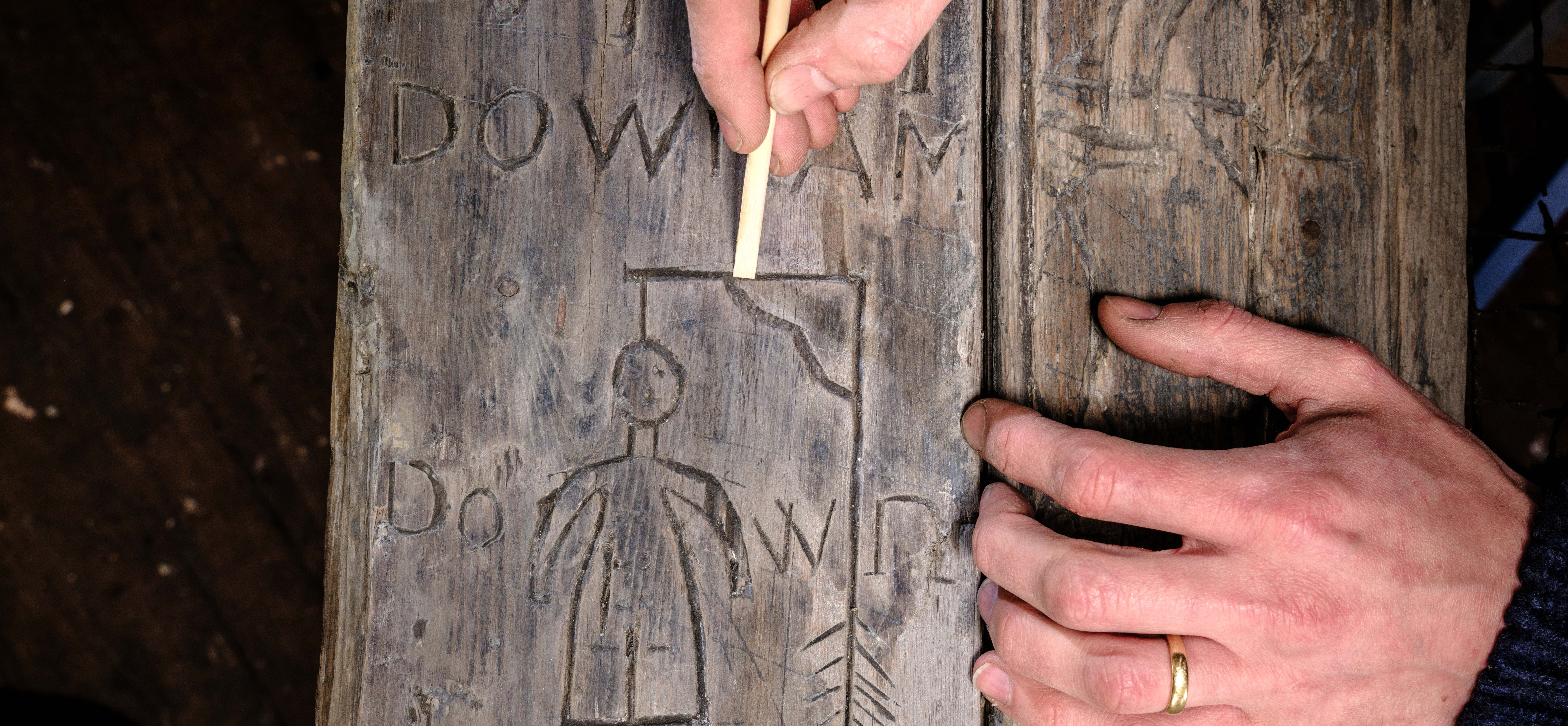15/05/2024
DOOR TO THE PAST: SOLDIERS’ GRAFFITI DISCOVERED ON CASTLE DOOR
- Georgian door at Dover Castle contains around 50 individual etchings, including name initials and chilling depictions of hangings
- Door will go on display in July as part of Dover Under Siege
A detailed carving of a sailing ship, the date of the French revolution (1789), nine macabre depictions of hangings, and countless initials are just some of the fascinating graffiti found on a newly discovered door dating to around the 1790s, English Heritage has revealed today (15 May). The door, which was originally located on an upper floor of the medieval St John’s Tower at Dover Castle in Kent, has been painstakingly conserved to go on display in July as part of Dover Under Siege – a new experience which will open up the castle’s northern defences, including the medieval and Georgian underground tunnels and Georgian casemates, to visitors.
With the palpable threat of invasion from Napoleon in France, Dover Castle underwent a transformation in the 1790s, from an aging medieval castle into a modern military garrison. Housing thousands of soldiers, it was necessary to build new barracks, as well as create new positions to defend from cannon fire and to bombproof the defences. St John’s Tower, which sat in the castle’s great outer ditch and so had a commanding view over the vulnerable northern end of the castle, would have been guarded by 6-12 men on duty at any one time, with 1-2 up on the tower. With tensions high but hours to kill, it seems that those men on duty put their questionable artistic talents to use, carving over 50 pieces of graffiti into the tower’s door with knives or possibly bayonets, with the earliest dated example from 1789 and the oldest 1855.
Paul Pattison, English Heritage’s Senior Properties Historian, said: “Scaling a ladder to the upper floor of St John’s Tower and seeing these remarkable carvings on the door was an astonishing discovery for us. This graffiti gives a unique glimpse into the minds of these soldiers, especially during such a charged period of time. As a result of the impending threat of war from across the Channel, Dover was a hive of activity with ships filling the harbour and coloured military uniforms a constant presence in the castle and town. What makes this door such an extraordinary object is that it is a rare and precious example of the ordinary person making their mark; whether that be simply for the purpose of killing time or wanting to be remembered.”

The St John’s Tower door contains around 50 pieces of carved graffiti. These include: three dates: 1789, the date of the French Revolution; 1798, a period of rebuilding in the castle; and 1855, when changes were planned to the tower. There are also many sets of people’s initials and two surnames: Downam and Hopper/Hooper. At least nine contain gruesome illustrations of hangings, a strange and macabre repetition, including one example where a man wears a military uniform and a bicorne hat. It is possible that this could be a depiction of a real hanging, as hangings were known to take place in Dover and did serve as morbid entertainment, or perhaps even a representation of Napoleon himself. Also present is a detailed and accurate carving of single-masted sailing ship, most likely an 8-gun cutter which was a fast vessel used by the Royal Navy, the Revenue Service, smugglers and privateers. Another curious symbol which depicts a glass or chalice for wine, surmounted by an elaborated cross, may be a representation of Christian holy communion.
After its discovery, the door was removed from St John’s Tower to protect and preserve it for future generations. It was also conserved by the careful removal of paint layers from the decorative surface of the door, and then the wood was then cleaned, toned and treated.
St John Tower’s Door will go on display at Dover Castle in July as part of Dover Under Siege.